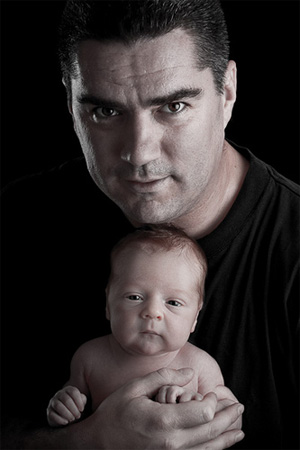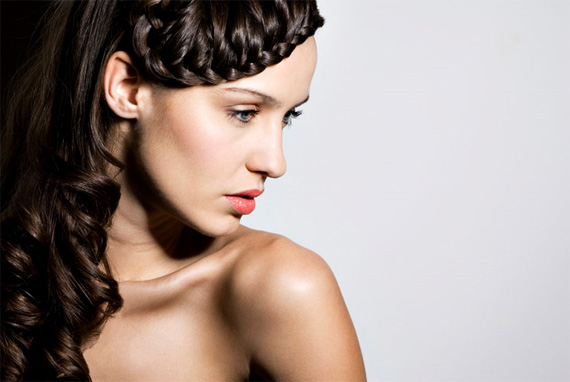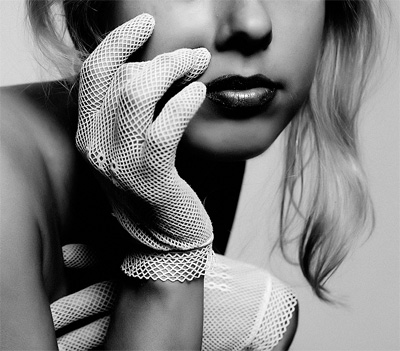Hair lights, back lights, and barn doors, oh my! Studio lighting can be overwhelming when you first start getting into it. Some photographers out there have thousands of dollars of accessories associated with their studio setup. The good news is that you don’t have to be rich to enter into the world of studio portraits. Think about it. How many light sources did God create for earth? If you said “one,” meaning the sun, you were almost right. He also created the sky and the ground to “bounce” that light into the shadows. Light that is bounced back is commonly referred to as a “fill light”. If there was no fill light on earth, anything not directly lit by the sun would have no detail; it would all be totally black.

“Trust” captured by PictureSocial member Adrian Adrianus
It is astounding how much you can do with one main light and one or two fill lights. For those of you thinking, “three lights doesn’t sound simple to me,” let me clarify. In this article what I am describing is one light and one or two reflective surfaces to help bounce that light or to fill in the shadows. With one light and one or more reflectors, you can make amazing photographs.
Having the tools and knowing what to do with those tools are two different things. Today I want to show you what to do with these basic tools:
1) Short light is the type of studio lighting setup where the face side of the subject farthest from the camera gets the main light. In this type of lighting setup, the side of the face which is toward the camera gets less light then the side facing away form the camera. The effect you get when using this lighting setup is a thin face. A photo tip worth remembering: short light helps to visually thin your subject.
2) Broad light is just the opposite of short light. The side that is getting the most light is the side facing the camera. This setup is less commonly used for portraits, as it tends to make people look wider. In both these cases, you can place a reflector on the opposite side of the light (at about a 45 degree angle) to help fill in the shadow side.

Photo captured by PictureSocial member Hugh O’Malley
3) Split light sounds more complex than it is. Position your main light on one side of your subject so that it’s exactly 90 degrees to the subject. In other words, you will see a dramatic shadow going right down to the middle of his or her face. If your main light is a flash, you might want to consider a secondary light; not for exposure . . . but just for light placement. We call this small secondary light a modeling light.
Using the modeling light, make sure the line between light and dark runs directly down the center of your model’s face, right down the tip of the nose. The model should be looking directly at the camera. This is what we call a split light portrait. Another photo tip: split light portraits create dramatic visual results.
4) Rembrandt light is considered an artistic classic. The main light is positioned high and on the side of the face that is away from the camera. Generally the subject is placed at a 45 degree angle to the camera (as opposed to just looking straight on). This technique produces an illuminated triangle on the cheek closest to the camera. The triangle will illuminate just under the eye and not below the nose. The face should appear illuminated on one side and heavily shadowed on the other.
Place your reflector (or white poster board) on the opposite side of the studio light. The reflector should be angled so that it reflects any remaining light in the room to the subject’s darken side. The key here is NOT to eliminate the dark shadows, but to add detail within the shadows. The third photo tip to remember: adding subtle detail makes images appear more artistic.
5.) Butterfly light is achieved by positioning the main light directly in front of the subject’s face and adjusting the height to create a shadow directly under, and in line with the nose. This style is best suited for subjects with an oval face and is considered to be a glamour style of lighting best suited for women. This lighting technique creates hard shadows in the eye sockets and under the chin depending on the size of your main light and distance to your subject. Use a reflector under the main light source to fill in the underside of the face (eye sockets, under nose and under chin areas). Sometimes this is referred to as “over and under lighting”.

“Untitled Portrait” captured by PictureSocial member Igor Umansky
Now, the setups given above can use extra lights, but they don’t have to. Just as you can take award winning photographs with a $50 camera or a $5,000 camera, you can also take great shots with a single light source. As we mentioned before, having the tools and knowing what to do with them are two totally different things.
It is my firm belief that photographers who master black and white photography first and then learn color photography will always have the advantage over those who started with color photography. This is not meant to insult younger photographers. If a cake tastes bad, it doesn’t matter what kind of icing you put on it. Learn the basics of good photography first, and then you can add more lights, more lenses, or whatever the case may be. Thus the final photo tip to remember is this: start with the basics, master them first. Then go forward.
About the Author:
Award winning writer / photographer Tedric Garrison has 30 years experience in photography (better-photo-tips.blogspot.com). As a Graphic Art Major, he has a unique perspective. His photo eBook “Your Creative Edge” proves creativity can be taught. Today, he shares his wealth of knowledge with the world through his website.
Like This Article?
Don't Miss The Next One!
Join over 100,000 photographers of all experience levels who receive our free photography tips and articles to stay current:






Thanks for sharing
how many Lighting in the studio of the 4 subjects?
Hi, I just bought a Samsung Galaxy camera
And found there is no “remaining shots” app in the camera. anyone can help to suggest what apps to download from Play Store for this function but at the same time will not affect the present Samsung camera and video function.
Tks
It has been a great sharing. thanks
This is very useful info. Thanks for sharing
great tips. thanks. :)